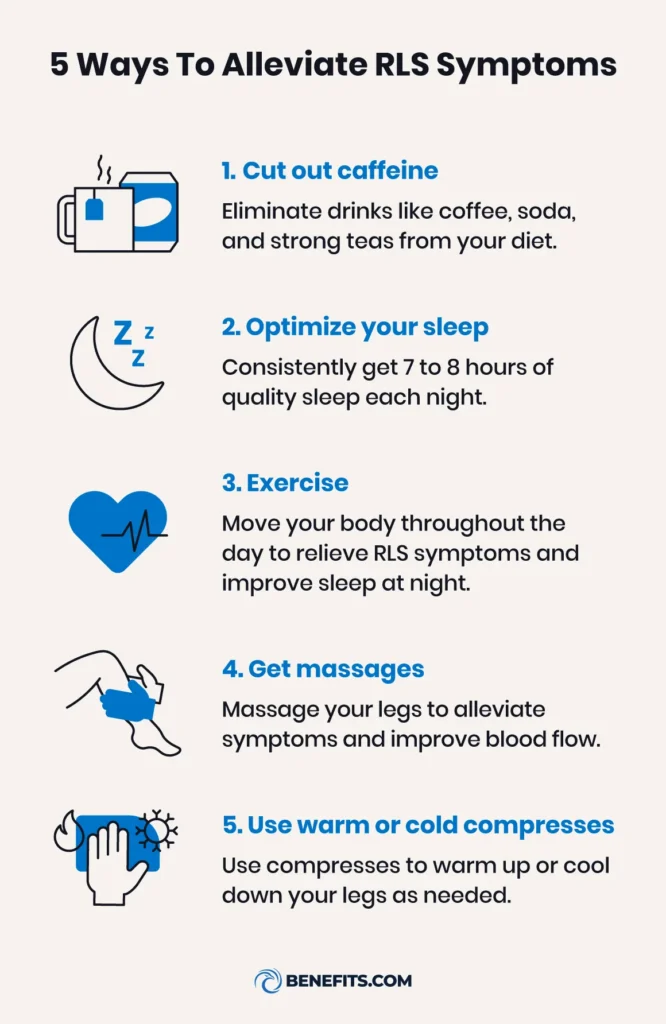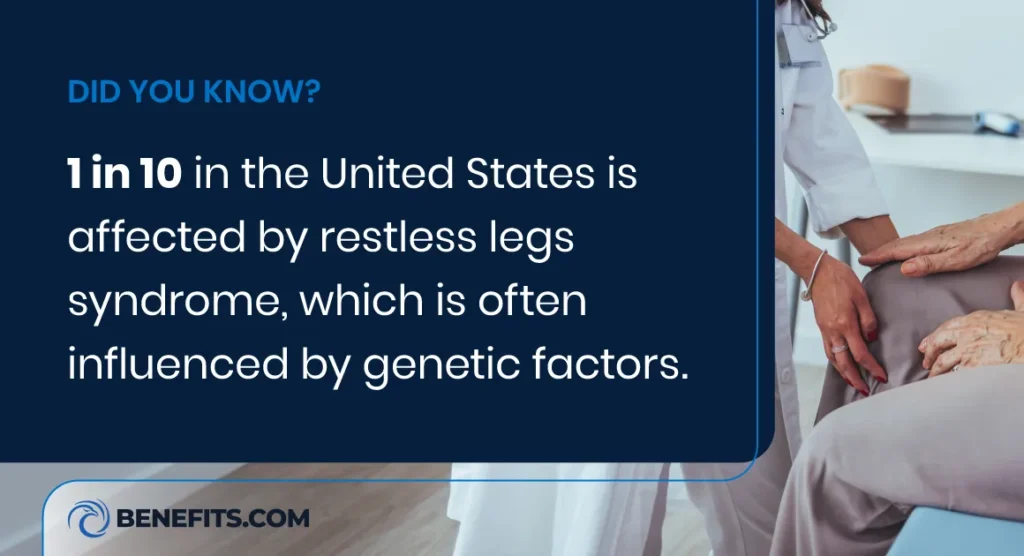Restless legs syndrome (RLS) is a neurological condition characterized by uncomfortable or painful sensations in one or both legs, often resulting in an uncontrollable urge to move the legs. A person experiencing RLS can receive a restless legs syndrome VA rating of mild (10%), moderate (20%), moderately severe (40%), or severe (60%) based on their symptoms.
The Department of Veterans Affairs (VA) uses ratings to determine a person’s eligibility for disability benefits. This guide will help you understand how to interpret a VA rating for restless legs syndrome so you can gain the appropriate benefits for your circumstances.
What Is Restless Legs Syndrome?
Restless legs syndrome, also known as Willis-Ekbom Disease, is a set of symptoms that create discomfort and agitation in the legs, usually in the evening or at night when a person is resting. Moving around can temporarily bring relief, though the condition can affect your mood, mental health, and sleep schedule over time.
Symptoms of RLS
RLS symptoms can manifest in many ways. Look for the following symptoms if you think you’re experiencing RLS:
- A strong compulsion to move your legs while attempting to rest
- An itchy, tingling sensation in one or both legs
- Sudden feelings of warmth across the skin
- Aches, pain, or spasms in either leg
- Feeling like bugs or electric currents are moving through your legs
Causes of RLS
Genetics and environmental factors heavily determine a person’s susceptibility to RLS. The following instances may cause RLS symptoms to surface in veterans:
- Genetics: You can inherit RLS, especially if symptoms appear before age 40.
- Iron deficiency: An iron deficiency can cause neurons to misfire, leading to RLS.
- Medication: Medications like antidepressants or antihistamines can cause RLS as a side effect of altering your hormones.
- Peripheral neuropathy: This occurs when nerves in your head, neck, arms, or legs get extensively damaged.
- Pregnancy: Hormonal fluctuations during pregnancy can cause RLS.
- Kidney failure: Compromised kidneys can lead to an iron deficiency, which may trigger RLS.

Is Restless Legs Syndrome a Disability?
RLS can be considered a disability if it hinders your ability to find and maintain gainful employment. For example, a severe case of RLS can make it difficult to work a job (i.e., office work or data entry positions) where you’re expected to sit and remain still for long periods.
How Does the VA Rate Restless Legs Syndrome?
The VA uses ratings to determine disability pay rates for eligible veterans. These ratings are broken up into percentages and can range from 10% to 100% from one condition to another.
RLS is broken up into four categories under diagnostic code 8620 of the Code of Federal Regulations: mild (10%), moderate (20%), moderately severe (40%), and severe (60%).
HTML Table:
| Description | Rating |
| Mild | 10% |
| Moderate | 20% |
| Moderately severe | 40% |
| Severe | 60% |
Other Conditions Connected to Restless Legs Syndrome
RLS shares some symptoms with other conditions, and it can also exacerbate others if left untreated. In these instances, secondary conditions can potentially lead to a higher VA rating if you’re able to verify connections between them.
Secondary conditions associated with RLS include:
- PTSD: Both RLS and PTSD can hamper your sleep quality and increase stress and anxiety.
- Iron deficiency: Abnormally low iron levels can cause neurotransmitters to work incorrectly.
- Parkinson’s disease: As Parkinson’s is a neurodegenerative disease, it can activate RLS symptoms as it impacts brain function.
- Sleep apnea: RLS and sleep apnea can create a cycle in which one condition triggers the other and disrupts sleep.
Can You Qualify for Total Disability With Restless Legs Syndrome?
Veterans with RLS may also qualify for Total Disability based on Individual Unemployability (TDIU) — another program created by the VA to help veterans with service-connected disabilities. To qualify for TDIU, veterans must meet the schedular or extraschedular requirements.
The schedular requirements for TDIU are:
- You have one condition with a 60% VA rating, and it’s proven to be a service-related disability.
- For example, you have a 60% VA rating for RLS and a letter from your doctor supporting your claim.
And the extraschedular requirements for TDIU are:
- You have multiple conditions with a combined 70% VA rating, one of which has at least a 40% VA rating.
- For example, a 20% RLS VA rating can still qualify if you have a 50% sleep apnea rating.
How To Qualify for VA Benefits for Restless Legs Syndrome
Qualifying for VA benefits requires very specific documentation from the appropriate entities. Here are the VA’s requirements for RLS benefits to help you improve your claim.

Receive a Diagnosis
Getting properly diagnosed by a licensed medical professional is the first step to qualification. A physician will review your medical records, discuss your symptoms with you at length, and perform a physical exam to gain a full scope of your condition.
The severity and complexity of your symptoms will influence the duration of this process. Mild RLS might be diagnosed in one to two visits, while severe cases that overlap with other conditions can take much longer.
If your health care provider concludes that your disability is service related, they can write a medical nexus letter to support your claim for disability benefits.
Gather Evidence of Your RLS Symptoms
This step calls for you to demonstrate how your RLS symptoms impact your daily life. Evidence may include:
- Documenting symptoms: Keep a detailed record of your symptoms, including their frequency, severity, and their impact on your daily life.
- Medical records: Collect medical records that document your RLS diagnosis and any treatments or interventions you’ve received.
- Lay statements: Obtain statements from family members, friends, or coworkers who have witnessed your symptoms and their effects on your daily functioning.
Attend a Compensation and Pension (C&P) Exam
C&P exams help the VA gain a full understanding of the conditions you’re currently experiencing. To receive the proper disability benefits you deserve, you’ll need to complete the following steps:
- Schedule the exam: Once you file a claim with the VA, they may schedule a C&P exam to evaluate your condition.
- Prepare for the exam: Bring all relevant medical documentation and be prepared to discuss your symptoms and how they affect your life.
- Attend the exam: A VA health care provider will assess your condition, ask about your symptoms, and possibly conduct a physical exam.
Establish a Service Connection
When you file a claim, the VA looks for a service connection to confirm that your condition began during or was worsened by your military service. Injuries, illnesses, or events that occurred as a result of your service constitute a service connection. Nexus letters will greatly help your case if a health care provider agrees that your injury stems from your service.
Frequently Asked Questions
Restless legs syndrome can affect everyone differently. The following questions are common among people who want to treat this condition in its various forms.
How Do You Test for Restless Legs Syndrome?
There isn’t a single test for RLS, though doctors can diagnose your condition based on a physical exam, neurological exam, your medical records, and your current symptoms.
In a physical exam, a doctor may check your leg muscles for weakness or study your joints for irregularities. Neurological exams can test your sensory organs, coordination, gait, reflexes, and spine.
How Are VA Ratings Assigned for RLS?
The VA adheres to the Code of Federal Regulations when assigning ratings to all conditions. For RLS, ratings range from 10% to 60%. Severity is determined by how much your symptoms impact daily life. There’s no single test for RLS, so a doctor’s examination and documentation of symptoms are crucial.
Is It Hard To Get VA Disability for RLS?
The length and difficulty of this process depend on your distinct circumstances. If you have a nexus letter from a doctor who supports your claim and evidence proving that your condition started in the military, there’s no reason you shouldn’t be approved for VA disability benefits.
Is There a Connection Between RLS and Other Conditions?
Yes, RLS is associated with several conditions that are very common in disability claims, including:
- Sciatic nerve damage
- PTSD
- Sleep deprivation
- Anemia
- Anxiety
- Brain fog
How Can I File a VA Claim for RLS?
You can file a claim for VA disability benefits for RLS using VA Form 21-526EZ. You’ll need to send all relevant information to the VA as you work on this form, and you have a maximum of 12 months from the date your form is received to submit any evidence that can bolster your claim.
Learn More About Your VA Disability Eligibility
While a restless legs syndrome VA rating of 10% applies to mild cases, veterans whose daily lives are severely impacted can qualify for a higher rating and greater benefits. Document your experiences thoroughly and get examined by a health care provider to strengthen your case for disability benefits.
Benefits.com is here to help veterans navigate the VA claims process for restless legs syndrome and other service-connected disabilities. To learn more, take our Benefits Quiz and find other benefits you may qualify for.
 Benefits.com Advisors
Benefits.com Advisors
With expertise spanning local, state, and federal benefit programs, our team is dedicated to guiding individuals towards the perfect program tailored to their unique circumstances.
Rise to the top with Peak Benefits!
Join our Peak Benefits Newsletter for the latest news, resources, and offers on all things government benefits.




















